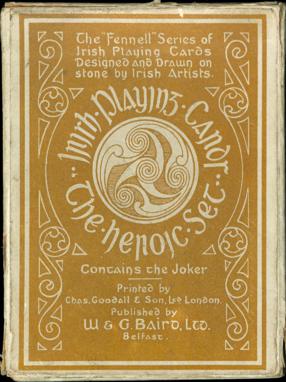 |
June 2012 |
|
There were
two collectors meetings this month. The first one was the annual trading
meeting at the National Playing Card Museum in Turnhout, Belgium, on
June 2nd and it was followed two weeks later by a collectors meeting in
Velddriel. Turnhout brought us some nice and interesting decks and one
of them had been on our wish list for years.
There was only one outdoor flea market that we visited and that brought
us nothing at all. But we kept a close eye on the playing cards offer at
the Dutch auction site and of course on eBay too.
So once
again we had an interesting short list. Among them was the new
re-edition of the Impure Forces in East Slavonic Mythology by Aleksej
Orleanski, a redrawn version in 36 cards, and the original antique
Belgian deck, that we only knew of a re-edition, advertising Amstel 1870
beer. Hors concours -but for us a truly great find for us- was a very
rare Dutch poster stamp, advertising the Amsterdam sales office of the
Speelkaartenfabriek Nederland. And then there was this deck. A nice, in
art nouveau style designed, Irish deck. That too had been on our wish
list, although not in the higher regions.
The Belgian deck will be shown in the "Variations" Xpo, so we
chose "The Heroic Set" for this spot. |
|
We had seen this
deck for the first time in Uwe Volker Segeth's book about Art Deco decks. There the
deck was attributed to the Irish Playing Card Manufacturing Co. and dated 1910.
The courts were "designed and drawn on stone" by an Irish
artist, whose name is -unfortunately- not mentioned anywhere, but his
or hers lovely art nouveau style definitely qualified it for a place in Uwe
Segeth's book.
Like it says on
the box, our deck here was made by Chas. Goodall & Son from London and published
by W & G Blaird Ltd. from Belfast as "The Heroic Set". The other
side of the box has a card glued to it to show the back design of the cards. The
name of Goodall on our Ace of Spades doesn't appear on the Ace of Spades from
Mr. Segeth's deck. That's the first apparent difference. An other difference is
the placing of the indices. In Uwe's deck they are placed in the corner of the
outline around the design, interrupting the line. In our deck the indices are
placed outside of the outline. The designs of the courts are exactly the same in
both decks. Uwe's deck measures 57 x 88 mm, our deck 64 x 89 mm. So our deck is
a bit broader, which explains why the indices could be set outside the
line.
So we may assume that our deck is a later re-edition, probably from the
1920's. |
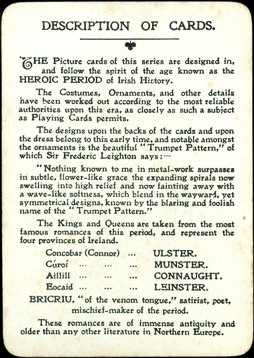
|
|
According to the
extra card, the depicted characters represent
four Irish provinces and the Kings and Queens were taken from famous romances
from the "Heroic Period in Irish history". Cú Roi represents Munster,
Eocaid the province of Leinster, Concobar Ulster and Ailill the province
of Connaught.
Our knowledge of Irish legendary tales was very close to zero. and when we
started researching the names in Wikipedia, the legends from the old Irish mythology turned
out to be very confusing for us, in regards to the used names, and only one famous
romance was found. Also two Kings didn't match with represented provinces,
according to the lists of Kings from the different Irish Kingdoms that we
found at Wikipedia. There was no Ailill among the Kings of Connaught (Connacht),
but several Eocaids and oppositely no Eocaids as Kings of Leinster, but
two times the name of Ailill is mentioned. So maybe Ailill and Eocaid were
mixed up by mistake on the extra card. |
We have given our findings here below, but maybe you should just enjoy the
images........
|
Cú Roi (mac
Dáire) is a King of Munster and his name appears in several
Mediaeval texts in legends, like the Táin Bó Cúailnge (Cattle Raid of
Cooley) or the Fled Bricrenn (Bricriu's Feast) |
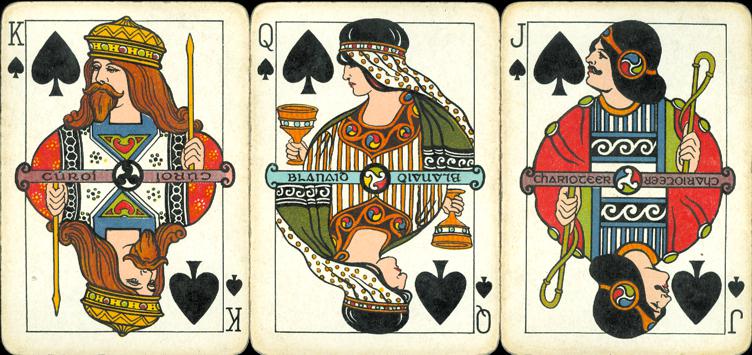
|
|
Blanaid, in
early Irish literature referred to as Bláthnat (little flower), was the
daughter of King Midir, fairy king of Bri Léith (located in the middle
region of Ireland). His Kingdom was invaded by Cú Roi and Cú Chulainn.
Despite her love for the latter, she's chosen by Cú Roi to marry him,
which led to a dispute between the two warriors. |
A repeated symbol
throughout the designs on the courts is the triskelion or triskele. It's in the middle of each of
the court cards. The Greek
triskelion or triskeles both mean three-legged and the symbol consist of
three interlocking spirals or bent legs or anything with three protrusions and a
rotational symmetry. The Celtic symbol consists of three conjoined spirals and
is in fact a Neolithic, pre-Celtic symbol, which was carved in a stone that was
found in Ireland and was dated around 3200 BC.
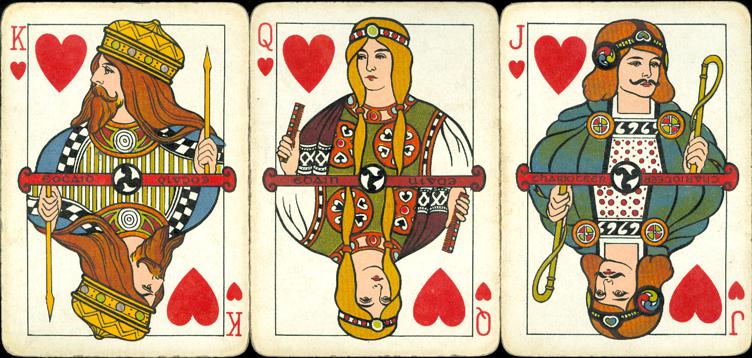 |
There were
several kings of the Kingdom of Connacht, whose name was Eocaid (Eochaid),
in the pre-historic ages. Eochaid Feidlech is said to be the father of
Queen Maeve (on QD), but there's also Eochaid Mugmedon, who is said to
be the father of Ailill. |
|
There was
no reference to be found about Edain in connection with one of the High
Kings of Ireland, nor in any other reference to Ireland in
general. |
|
Eight of the triskeles on the courts are black against a
white background, one is in brown against a white background and three
are white against a three-colour background. It seems to have been done
randomly. |
| |
|
There
were several Kings with the name Concobar (Conchobar). The name means
"lover of hounds" in Irish. One of the more famous Kings was Conchobar
mac Nessa. He was a King of Ulster and he too was shortly married to
Queen Maeve.
|
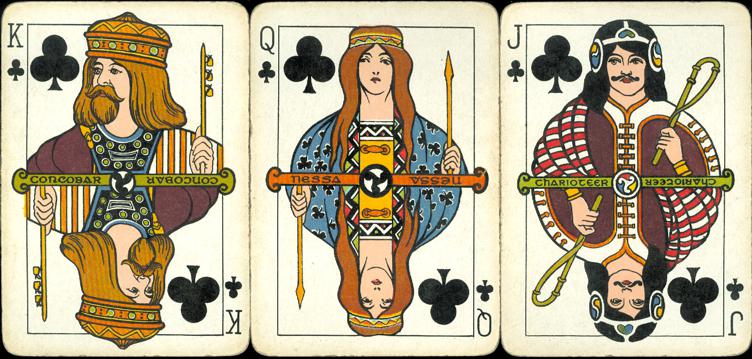
|
|
Nessa (or
Ness) is a princess of the Ulaid and she's the mother of
Conchobar mac Nessa in the Ulster Cycle of Irish mythology. |
The triskele symbol
is also used as decoration of the Jacks' hairbands, on the dress of the Queen of
Spades and King of Diamonds .
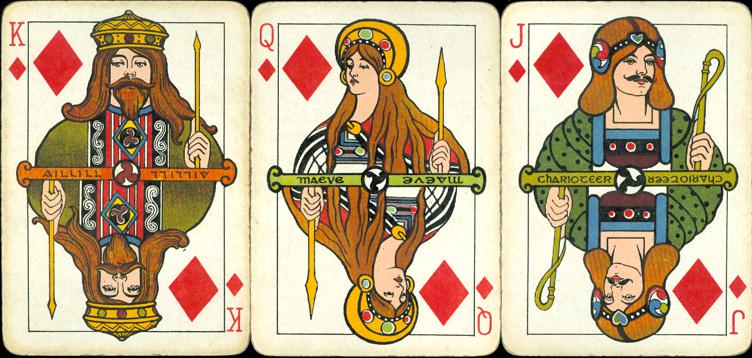 |
Aillill (mac
Máta) is one of the Kings of Connacht, an Irish province. He's the husband of Maeve and
in the Táin Bó Cúailnge legend the two went to war against
Ulster with the intend to steal the stud bull Donn Cúailnge. |
|
Maeve is a
first name of Irish origin. In Irish Gaelic, the name "Medbh"
means "she who intoxicates." Here it's very likely to refer to Queen Maeve or
Medb
from the Táin Bó Cúailnge legend. |
The deck consists
of 52 cards, an extra card and a joker. The back design shows Celtic symbols, just
like the Ace of Spades.
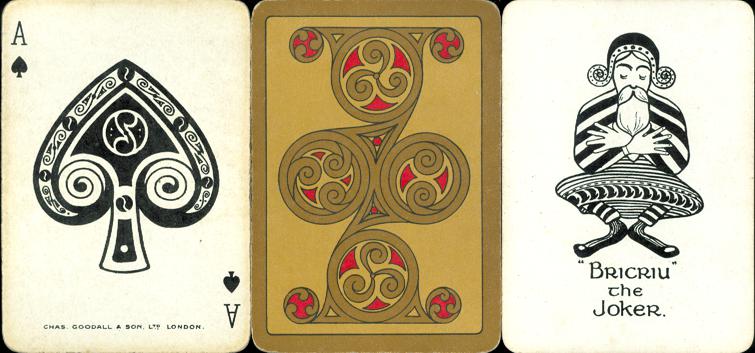
Bricriu, the joker,
probably refers to the Bricriu from the "Fled Bricrenn" (Bricriu's
Feast), a story from the Old Irish mythology. In this tale Ailill, Maeve and Cú
Roi also play a part. Briciru, a hospitaller, is casted as a troublemaker
in this tale.
BACK TO PRESENT MONTH






